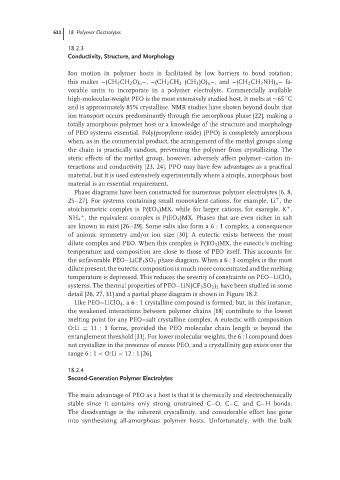Page 658 - Handbook of Battery Materials
P. 658
632 18 Polymer Electrolytes
18.2.3
Conductivity, Structure, and Morphology
Ion motion in polymer hosts is facilitated by low barriers to bond rotation;
this makes –(CH 2 CH 2 O) n –, –(CH 2 CH 2 (CH 3 )O) n –, and –(CH 2 CH 2 NH) n –fa-
vorable units to incorporate in a polymer electrolyte. Commercially available
◦
high-molecular-weight PEO is the most extensively studied host. It melts at ∼65 C
and is approximately 85% crystalline. NMR studies have shown beyond doubt that
ion transport occurs predominantly through the amorphous phase [22], making a
totally amorphous polymer host or a knowledge of the structure and morphology
of PEO systems essential. Poly(propylene oxide) (PPO) is completely amorphous
when, as in the commercial product, the arrangement of the methyl groups along
the chain is practically random, preventing the polymer from crystallizing. The
steric effects of the methyl group, however, adversely affect polymer–cation in-
teractions and conductivity [23, 24]. PPO may have few advantages as a practical
material, but it is used extensively experimentally where a simple, amorphous host
material is an essential requirement.
Phase diagrams have been constructed for numerous polymer electrolytes [6, 8,
25–27]. For systems containing small monovalent cations, for example, Li ,the
+
+
stoichiometric complex is P(EO 3 )MX, while for larger cations, for example, K ,
NH 4 , the equivalent complex is P(EO 4 )MX. Phases that are even richer in salt
+
are known to exist [26–29]. Some salts also form a 6 : 1 complex, a consequence
of anionic symmetry and/or ion size [30]. A eutectic exists between the most
dilute complex and PEO. When this complex is P(EO 3 )MX, the eutectic’s melting
temperature and composition are close to those of PEO itself. This accounts for
the unfavorable PEO–LiCF 3 SO 3 phase diagram. When a 6 : 1 complex is the most
dilute present, the eutectic composition is much more concentrated and the melting
temperature is depressed. This reduces the severity of constraints on PEO–LiClO 4
systems. The thermal properties of PEO–LiN(CF 3 SO 2 ) 2 have been studied in some
detail [26, 27, 31] and a partial phase diagram is shown in Figure 18.2.
Like PEO–LiClO 4 , a 6 : 1 crystalline compound is formed, but, in this instance,
the weakened interactions between polymer chains [18] contribute to the lowest
melting point for any PEO–salt crystalline complex. A eutectic with composition
O:Li = 11 : 1 forms, provided the PEO molecular chain length is beyond the
entanglement threshold [31]. For lower molecular weights, the 6 : l compound does
not crystallize in the presence of excess PEO, and a crystallinity gap exists over the
range 6 : 1 < O:Li < 12 : 1 [26].
18.2.4
Second-Generation Polymer Electrolytes
The main advantage of PEO as a host is that it is chemically and electrochemically
stable since it contains only strong unstrained C–O, C–C, and C–H bonds.
The disadvantage is the inherent crystallinity, and considerable effort has gone
into synthesizing all-amorphous polymer hosts. Unfortunately, with the bulk

